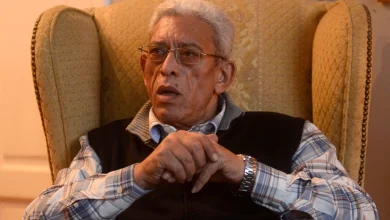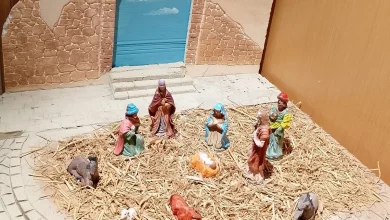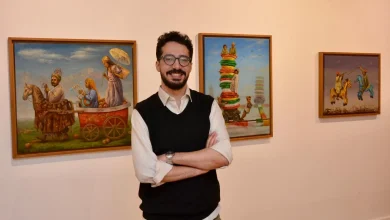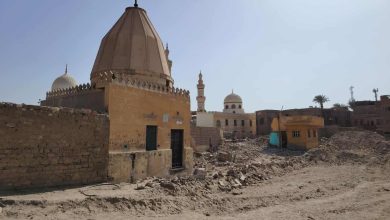Samar Dweidar: Palestinians are not numbers… and “Palestinian Stories” is proof

Behind every Palestinian martyr and victim, there is a story that the news reports never tell, dreams that never had a chance to come true. Victims are often counted as numbers, without regard for the lives that were cut short before they could be lived. This is how the “Palestinian Stories” initiative was born, the brainchild of Egyptian researcher Samar Dweidar, who chose to take a different path: rather than documenting events, she documents people, their lives and their simple dreams.
The project began by chance, when she stumbled upon her grandfather’s archive: hundreds of photos and letters that opened a window onto a whole Palestinian life that had never been recorded in history books. From this personal treasure trove, her literary project turned into a vast documentary work that redraws Palestinian memory from within, through the details of everyday life.
In this interview with Bab al-Masr, Daidar reveals how the family archive became a humanitarian initiative that tells the truth about the past and the tragedy of the present in Gaza, in the words of those who lived it.
Palestinian stories
In 2019, Egyptian researcher Samar Doidar began her novel based on the testimonies of Palestinian women in the diaspora. These women do not know each other, but what brings them together, she says, is that their families left Palestine in 1948 and the displacement and suffering that followed in exile.
Samar, who was born to an Egyptian father and a Palestinian mother, did not write a traditional novel, but rather began with field research in oral history. However, the rich human details contained in these testimonies prompted her to turn the project into a novel.
She immersed herself in meticulous social research: “I was looking for everything: how did women style their hair? What did they wear? How did they get around? How did they speak?” she says.
Because she was writing about cities she had never set foot in, she realised that small details could lend credibility to the text. During her research, her mother gave her an old box she didn’t know existed. It was an archival treasure trove: more than 350 letters and documents and 600 family photos belonging to her Palestinian grandfather, covering the period between 1926 and 1966.
From the beginning
This is how the “Palestinian Stories” project was born, a family oral history project that Samar started in September 2019 and continues to this day. She tells Bab Al-Masr: “The Palestinian Stories initiative is not content with simply telling stories, but gives them a human dimension so they can be read as literature and documented as history.”
However, she did not expect her writing to turn into a large-scale documentary project. She stopped writing the novel she had started after finding herself immersed in an amazing family archive that she stumbled upon by chance in an old box her mother had given her.
In this box were hundreds of photographs and letters written by her Palestinian grandfather, who had emigrated to Egypt in 1947 for work and never knew that he would never return to his homeland due to the Israeli occupation of Palestine. This box was like a treasure trove, bringing the Egyptian researcher back to the lives of Palestinians that no one ever talked about.
She immersed herself in her grandfather’s archive, and the idea of collecting her family’s archive for her family in the diaspora came to her. The ambitious idea of reconstructing Palestinian memory, not through official history books, but through the voices of the people, their photos, their letters, and the small details of their lives that had never been seen before, quickly developed.
The first exodus from Gaza to Jerusalem in 1916
Letter from Ali Shath to his wife Samiha, dated 7 September 1956.
According to the website Palestinian Stories:
Amman, 7 September 1956
Hotel Philadelphia
My dear Samiha,
Yesterday, I was walking down the main street in Amman when an elderly man stopped me and greeted me warmly, saying in a blessed Khalili dialect: “Salamat… You’re here… Come here, my son… Come here and give me a hug…”
It was Muhammad Asaad Marqa, my classmate when we were children at the school in Hebron in 1916. We used to sit on the same mat with Rashad al-Shawa, as there were no seats in the classroom… I remembered the tall eucalyptus tree where he and I used to sit in the shade during lunch break, sharing a “kardush” of corn, an onion, a few dates, and lots of za’atar or dقة, to help us memorise our lessons and improve our recitation of the Holy Quran.
I remembered all this in a few moments, as I remembered his skill at catching birds with his slingshot and his skill at “stealing” figs from the Tahboub family’s garden next to our house… May God bless those days… the days of our golden age.
At that time, we were in the midst of the First World War. The British destroyed Gaza by bombing it relentlessly from the sea, forcing the inhabitants of this poor city to flee and “run away” with only the clothes on their backs, wandering aimlessly, leaving their homes and possessions behind, because of the fire and destruction, not caring about anything. Thus, the people of Gaza were the first to experience displacement and migration, and they were the first refugees in Palestine. We fled to Beersheba, then the British came after us, so we fled to Hebron, and from there to Jerusalem, until Turkey entered and the British occupied our country, beginning a new long series of torment, pain, slavery and displacement…
I travelled a little and my childhood friend Marqa and I parted ways, agreeing to meet again in Hebron, God willing.
Your husband, Ali Shath
An archive that gives Palestinians back their stories
Samar, who has managed projects to provide counselling and psychological and social support to those affected by wars and disasters in Egypt, Lebanon and Palestine, says: “I postponed the novel because I felt that the letters I had in my hands were real and much more powerful than any history book or information circulating on social media. These are direct testimonies from people who lived through the events and wrote about them to their wives, children and friends. It is very honest, heartfelt and gives me – and others – a real insight into Palestine, which I have never visited.”
More than 350 letters, documents and photographs belonging to her Palestinian grandfather formed the nucleus of her documentary project. Samar began archiving this personal archive, which then turned into travelling exhibitions in Egypt, the United States, England, Jordan and, most recently, Turkey.
During that period, she had the idea of creating a website where her relatives scattered across the diaspora could gather this history, so that it would remain alive and accessible to them. However, with the outbreak of the coronavirus pandemic in 2020, the project took on a new dimension.
Exhibition for the Palestinian Stories initiative in the United States – 2020
Exhibition for the Palestinian Stories initiative in Istanbul, Turkey – May 2025
Preserving the Palestinian narrative
Samar Dweidar believes that this is no longer just a matter of one family’s archive, but of an entire people. She realised that there are thousands of Palestinian families who have lost their archives or have no one to document their stories. So she decided that Palestinian Stories would be an open platform for any Palestinian – especially those who have never visited Palestine – to build their personal archive and recover their memory.
Samar says, “The issue is no longer just about martyrs, fighters or those described as terrorists, but about ordinary Palestinians whom no one talks about. Family archives restore people’s dignity as individuals, as mothers, fathers and children.”
The initiative aims to bring Palestinians back to the forefront as human beings who lived their stories, hopes and losses, not just as “numbers” of dead and wounded. It seeks to preserve the Palestinian narrative in the face of global narratives that reduce Palestinians to stereotypes.
Dweidar believes that preserving memory, especially in light of the displacement and dispersion of the third and fourth generations outside Palestine, is essential to keeping the cause alive. She says: “Personal stories reopen dialogue between different and scattered Palestinian families and give young people born abroad a link to their past and to a homeland they may never have seen, but whose features they can observe in a photograph or in a line written in the handwriting of a grandfather they never knew, but who lived in Palestine.”
Palestine between historical and family narratives
Researcher Samar Dweidar believes that the relationship between the official narrative of history and oral history is not one of conflict, but of complementarity. Each plays a role in shaping a deeper understanding of the truth.
She explains: “The historian who recounts historical events waits for the end of the war to analyse what happened and offer their perspective, but this perspective is not necessarily wrong or objective, and they may not have experienced the event themselves. The family narrative, on the other hand, is a voice from the heart of the crisis, telling how people lived through it.”
The Palestinian Stories project combines human narrative and family documentation, emphasising the importance of plurality in Palestinian storytelling and the need for it to be told in the voices of its protagonists, without interference or censorship.
The initiative is based on an independent social archive that is not subject to any authority that decides what should be published or deleted. Samar adds: “The website is open to any Palestinian who wants to upload their family archive and choose what they want to share. The only criteria are honesty and accuracy, so that this archive can be a reliable source for researchers and a mirror of the reality of real families.”
Ibrahim Musa Mikhael and Aziza Khalil Mikhael during their engagement in Ramallah in 1932 The Mikhael family Palestinian Stories website
The diaspora and the destruction of archives
The initiative faces significant challenges in collecting archives, most notably the repeated displacement of Palestinian families in the diaspora and a lack of awareness of the role of family archives as a tool of resistance.
“We hold awareness-raising meetings to emphasise the importance of family archives in resisting the deliberate erasure of Palestinian memory,” says Dweidar. “We also use the website and social media platforms to raise awareness of the value of archives.”
She adds: “Diaspora and repeated displacement have destroyed many archives. That is why we need to take a long-term approach and maintain direct human contact with families. Between January and June 2025, we were able to access the archives of 22 families, and we hope to document the archives of 75 families by the end of the year.” Among the families registered are: Shath, Al-Rayes, Jarrah, Al-Hassri, Abu Ramadan, Joda, Al-Ghaziya, Al-Husayni, Mikhael, Kanaan, Al-Khalis, and others.
Testimonies from Gaza
The project is not limited to stories of the past, but has evolved to document the present, especially what is happening in Gaza. Samar says: “Since October 2023, documenting what is happening has become a matter of life and death. What is happening today brings to mind the Nakba of 1948, but the difference is that we have new tools for documentation, and the genocide is happening before our very eyes.”
Thus, a new section of the project was born, documenting the testimonies and contributions of Palestinians inside Gaza through their posts on social media. Samar sees this as a new form of archiving, realistic, direct, and in the language of the people themselves.
She emphasises that her goal is not to repeat what is reported in the media, but to capture the everyday human details that make up life in the midst of war. Through “Palestinian Stories,” the team of volunteers has collected more than 3,000 testimonies from inside Gaza since the start of the war in 2023. Six hundred of these testimonies have been archived and 260 published on the website, in a database designed to be an open and reliable reference for those seeking the true Palestinian narrative.
Press card Editor-in-chief of Akhbar Filastin newspaper, Mohammed Zaki Al-Radwan Al-Radwan family Palestinian Stories website
Western perspective
The work was not limited to the Palestinian interior, but extended to a global audience. Samar says that the interaction with foreign exhibitions was remarkable, especially from non-Palestinians.
She recounts an archival exhibition organised in Britain, attended by an audience of left-wing and socialist British people, many of whom felt ashamed of their country’s colonial history and Britain’s role in handing Palestine over to occupation. Among the attendees was British historian Julia Bush. Julia is a professor of history and a member of the Palestine Museum in Bristol. She was deeply moved and told Samar: “For the first time, I see the ordinary, human life of Palestinians in detail, far from the stereotypes in the media.”
One of the most notable exhibits was a letter written by Samar’s grandfather in warm language describing his trip to Egypt in 1947 to attend the opening of the first branch of the Arab Bank in Alexandria, accompanied by his family, on a journey he hoped would end with their return to Palestine. Another letter he wrote describes his visit to Jerusalem in 1952 for the first time after the occupation.
From family archives to collective memory
British historian Julia was deeply moved when she visited the “Palestinian Stories” exhibition, saying that these testimonies represent the first “primary source” from the other side of the issue – the Palestinians. She noted that she had always read Jewish accounts of the Holocaust and Nazi persecution, but had never had a similar opportunity to hear Palestinian accounts with such intimacy and honesty.
Samar commented on this moment: “This was the third exhibition I had presented, and I was still testing the impact of the stories on the audience. But Julia’s comment took me from feeling that this was just a family archive to realising that what we have is living history that should be accessible to everyone. There are definitely others who have stories that deserve to be documented and celebrated.”
For the most recent exhibition, held in Turkey, Doidar insisted on presenting it in both Arabic and English. “Arabic is the original language of the stories, and it was very important to present them in Arabic. We translated everything voluntarily, with the help of Fatima Al-Qalai and Shireen Al-Banhawi. During the exhibition, we presented the archives of six Palestinian families in the language of the storytellers.”
Future partnerships
Dawidar believes that documentary work cannot be done in isolation. She has begun attempts to connect with institutions interested in Palestinian archiving and memory, with the aim of building an integrated network of cooperation.
The partnerships have not yet been realised, and she continues: “Every institution has its own plan and priorities, so cooperation is often through joint seminars, participation in exhibitions, or workshops. But we are working to expand our network with institutions working in the same field, because this type of work requires integration, not competition.”
She points to the role of pioneering institutions such as the Palestine Museum, which focuses on archiving documents belonging to prominent Palestinian families and figures in Palestinian history, as well as the Khazayn Foundation in Jerusalem, which documents everything printed, from cinema and travel tickets to event cards, from the late 19th century to the present day, with a small space dedicated to family archives.
But what distinguishes the “Palestinian Stories” project, she says, is its focus on social history and family archives: “Those who come to the exhibition or participate in our events are looking for the Palestinian people, not a political stance.”
Sheikh Jawad at the closing ceremony of the Holy Sepulchre on Saturday, 5 May 1956. The Joda Al-Ghadba Al-Husayni family – Palestinian Stories website
Avoiding political conflicts
Dweidar refuses to introduce politics into the project, whether in writing or documentation, even though she has personal opinions like any individual. She adds: “We don’t write about the differences between Fatah and Hamas, or about internal political conflicts, because the goal is the Palestinian people and documenting their daily, family and personal memories. Politics is not absent from our lives, but it is not the focus of what we document.”
She adds that the audience interacting with the project is diverse: researchers, artists, Palestinians in the diaspora, and non-Palestinians interested in the human history of the cause.
She believes that the strength of the project lies in this human approach, which she deliberately uses as a bridge to reach others, especially Western audiences. “I was greatly inspired by the Zionist experience in using propaganda through art, cinema and human documentation.”
She adds: “I visited the Holocaust exhibition in Washington, and I was struck by how they focused on the human aspect and made the viewer empathise with them through images, letters and artwork, rather than direct political discourse. This is what I see in Palestinian Stories: we are telling real stories.”
Reactions from around the world
Five years ago, Samar made a short documentary about the life of her Palestinian grandfather, Ali Rashid Shath, based on his letters, photographs and personal archives. She considered her strong emotional response to the film natural, given that it was about her grandfather, but what she did not expect was the extent of the reaction it provoked from an audience that knew nothing about Palestine or her grandfather.
“Every time I watch the film, I feel like I’m seeing it for the first time,” says Samar. I thought this was because of my personal connection to it. But when I showed the film to a non-Arab audience, including a Japanese girl, a European, and two people from Turkey, I discovered that its impact transcends language and geography.”
After the screening, she was surprised by the strong emotional reactions. The most notable was the comment of the Japanese girl, who said: “My country is far removed from this conflict, but the film touched something inside me… about loss, homeland and nostalgia.” Although the events of the film document a period of my grandfather’s life dating back to 1952, the emotions it conveyed were vivid and able to reach anyone.
They are not numbers
“People are not numbers, and my mission in ‘Palestinian Stories’ is to restore their faces, voices and memories,” says Dweidar, noting that her entire project is still based on volunteer work.
She continues: “Since the initiative was launched, more than 70 people have volunteered with us over the course of five years, including researchers, designers, translators and documenters. Even the launch of the website in 2023 was made possible with significant symbolic support from influential figures such as Dr Imad Abu Ghazi.”
She believes that 2025 will be a pivotal year for the project, as she aspires to move from volunteer work to formal establishment. She is seeking cultural and institutional support to ensure the continuity of the archiving process, especially given the urgent need to preserve Palestinian narratives that are often marginalised or lost.
Read also:
Antiquities dealer who sold looted Egyptian artefacts worth €50 million on the run… Will the case be closed? | Documents





Hi, this is a comment.
To get started with moderating, editing, and deleting comments, please visit the Comments screen in the dashboard.